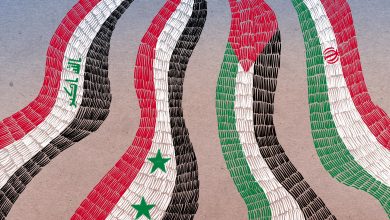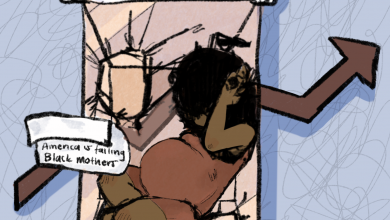You can’t freeze Olympic LGBTQ+ expression

Design by Haiqi Zhou
Image description: Timothy LeDuc (left) with partner Ashley Cain-Gribble (left) and Ireen Wüst (right) skating on a Progress Pride flag on ice.
When a Dutch child puts on their ice skates for the first time, they step into a river flowing with nationalistic pride, orange flags and Olympic glory. As they trace lines in the ice, their nose turns red and they hold their parent’s hand. Although they are freezing in the cold, a fire burns within. Little compares to the Dutch when it comes to their enthusiasm for speed skating. At the center of this cold, icy form of worship is Ireen Wüst, who shone in Beijing by becoming the first Olympian to win individual gold at 5 separate Olympics.
Despite her superstar status, Wüst was just one among the star-studded lineup of Olympians. The skater shared the stage with triumphant stories such as that of the USA’s figure skater Timothy LeDuc, the first openly non-binary winter Olympian to compete. Whilst both athletes belong to the LGBTQ+ community, they use their Olympic platform for advocacy in very different ways. This contrast prompts us to reexamine what it means to be an activist, and the way we expect Olympians to exist in a public space. Should the Olympics just be about sports, or should we allow space for expression and activism, particularly for athletes in marginalized groups? Most importantly, where do norms and values regarding activism on the Olympic platform come from?
When Ireen Wüst was asked about her sexuality in 2010, she replied bluntly with a comparison, “I want to talk about ice skating. You are not asking [fellow Olympian] Sven Kramer about how his relationship is going. So why would you ask me? If I would’ve had a relationship with a guy, you wouldn’t have asked me either.” Her focus on her sports caused friction in certain divisive Olympic destinations; Russia’s anti-LGBTQ+ culture, including an anti “homosexual propaganda” law, prompted Dutch politicians to urge Wüst to make a statement or display activism throughout the Olympics. Yet, she was not to be distracted — in the period leading up to the Olympics, Wüst’s world grew smaller and smaller, focusing on the one goal that trumps them all: gold. Everything else is a distraction, taking her away from what is truly important. As she races in her classic calm, muscle-driven style, she is a force to be reckoned with. As an Olympic legend, she regards her sexuality to be the least interesting thing about her. In fact, Wüst has been adamant that her bisexual identity should not be the center of the story and should be considered normal rather than the focus of a headline.
Turning away from speed and power, elegance and expression takes center stage on the icy Olympic figure skating platform. Timothy LeDuc’s activism on skates takes on a very different shape, as they color their figure skating routines with powerful messages. Their routine with skating partner Ashley Cain-Gribble during the Beijing Olympics demonstrated non-traditional gender roles. Partnered figure skating is traditionally made up of strong men lifting petite women high up above the air in a show of patriarchal dominance and submission, sketching the narrative of a sweeping love story on ice. Being non-binary in this sport means to constantly battle gender roles that are not only societal, but systemically engrained into the definition of what figure skating is. It is therefore no wonder that LeDuc struggled growing up, being told that “being gay was going to be a liability” or that demonstrating “how masculine you are” would allow them to win.
Existing as a non-binary person in figure skating is an act of resistance in and of itself due to the sport’s heavily engrained gender roles. However, LeDuc doesn’t stop there. Aside from creative agency which permits an expression of their identity, they speak openly to the press about their experiences with things such as gay conversion therapy, pride and discrimination. The power of the Olympic platform itself motivates them to speak out, as LeDuc belongs to a growing group of out queer people in traditionally gendered sports. Hyper-masculinity and stereotypes are not unique to figure skating. LGBTQ+ discrimination is embedded within sports culture, especially in in male-dominated sports such as football and basketball. Such sports preserve stereotypes of physical male dominance through a lens of heteronormativity in which homosexuality is traditionally equated with weakness. Thus, an anti-LGBTQ+ culture runs deep through the veins of a traditionally hyper-masculine patriarchal sports world. When LeDuc speaks, they are aware that their work is only a small contribution in all that needs to be done to help an LGBTQ+ community of athletes facing daily discrimination in their respective sports.
“My hope is that when people see my story, it isn’t focused on me and saying, ‘Oh, Timothy is the first out non-binary person to achieve this level of success in sport. My hope is that the narrative shifts more to, queer people can be open and successful in sports. We’ve always been here, we’ve always been a part of sports. We just haven’t always been able to be open.”
What causes LeDuc to be so expressive and open in their activism, and Wüst to shut down questions regarding her identity? The nature of the sport itself plays a role. The creative side of figure skating lends itself to more agency and expression, in which activism becomes possible. This is not possible with speed skating, for instance, where there is less flexibility in how you enter the ice rink. Moreover, the issue at stake is vastly different: LeDuc’s non-binary identity is central to their interaction with the traditionally gendered figure skating roles, whereas Wüst’s sexual orientation does not provide this constant friction. The call to activism felt from within is therefore also a qualitatively different experience. Nonetheless, the Olympics is a platform for representing one’s country and culture in sports, so it would be naive to ignore the role that culture plays in one’s activism.
Whilst Dutch children put on their ice skates, they hear their parents talking in the background: “Als je gewoon doet, doe je al gek genoeg,” they might murmur, giving a side eye to an extravagantly dressed figure skater on the ice skating rink. The saying translates to, “If you just act normal, you are already unique enough.” In a culture where the royal princesses attend public school and the prime minister bikes to work, flaunting is a source of shame unlike any other. Although the Netherlands isn’t a collectivistic country, one’s individualism is best appreciated in a mellow, easy to digest form. All the traits that make someone unique should also be normalized to an extent where there is no need to flaunt them.
For Ireen Wüst, activism means normalcy. It means being able to marry her girlfriend without questions and being able to focus on sports without the expectations of activism. On the contrary, the more expressively individualistic culture of the United States of America tells us that speaking up is important. A message is best expressed through standing out from the crowd, and deviating from the norm. To be an activist, Colin Kaepernick takes a knee, Billie Jean King competes in a ‘Battle of the Sexes’ and LeDuc alters the skating routines. Their individual expression persists despite the fact that they are threatening their country’s status quo. Often, these acts of resistance are shaped by intersectional activism, influenced significantly by communities of color in the US resisting the colonialism and racism the country was built on. Despite oppressive systems present in both countries, the influences of collective action and organizing are evident in the athlete’s individual contributions to building towards liberation. Overall, the different forms of activism are influenced both by the sport, the nature of the issue, and the cultural values of the country – or in spite of the country – athletes are representing.
This comparison of the two LGBTQ+ athletes should not act as a competition, comparing queer athletes to show who is worthy of attention. It should not pit the marginalized against each other to battle it out for being the ‘model gay athlete.’ Instead, both forms of demonstrating pride for their identities are byproducts of each athlete’s respective culturally influenced form of expression and can place into context why one acts the way they do. It provides a glimpse into the world which influences activism, demonstrating the sea of options LGBTQ+ athletes have to be themselves unapologetically. So if the lakes freeze over this winter and I put on my ice skates in the Netherlands, I am filled with not just my personal Dutch pride, but pride for the LGBTQ+ community, which dances fiercely and beautifully, despite attempts from the world to freeze us into position.




